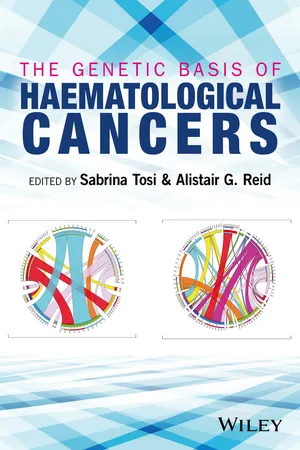
- English
- ePUB (mobile friendly)
- Available on iOS & Android
The Genetic Basis of Haematological Cancers
About This Book
Written by a team of international experts, this book provides an authoritative overview and practical guide to the molecular biology and genetic basis of haematologic cancers including leukemia. Focusing on the importance of cytogenetics and related assays, both as diagnostic tools and as a basis for translational research, this is an invaluable guide for basic and clinical researchers with an interest in medical genetics and haemato-oncology.
The Genetic Basis of Haematological Cancers reviews the etiology and significance of genetic and epigenetic defects that occur in malignancies of the haematopoietic system. Some of these chromosomal and molecular aberrations are well established and already embedded in clinical management, while many others have only recently come to light as a result of advances in genomic technology and functional investigation. The book includes seven chapters written by clinical and academic leaders in the field, organised according to haematological malignancy sub-type. Each chapter includes a background on disease pathology and the genetic abnormalities most commonly associated with the condition. Authors present in-depth discussions outlining the biological significance of these lesions in pathogenesis and progression, and their use in diagnosis and monitoring response to therapy. The current or potential role of specific abnormalities as novel therapeutic targets is also discussed. There is also a full colour section containing original FISH, microarrays and immunostaining images.
Frequently asked questions
Information
Chapter 1
The myelodysplastic syndromes
Introduction
Predisposing conditions
| Disease | Inheritance | Gene | Locus | Other features | Incidence of MDS/AML (%) |
| Severe congenital neutropenia | AD | ELANE | 19q13 | None | 10 |
| AD | GFI1 | 1p22 | Monocytosis Lymphopenia | ||
| AR | GSPC3 | 17q24 | Cardiac and urogenital malformations | ||
| AR | HAX1 | 1q21 | Neuropsychological defects | ||
| XL | WAS | Xp11 | Monocytopenia Low NK cells | ||
| Shwachman–Diamond syndrome | AR | SBDS | 7q11 | Exocrine pancreatic insufficiency, bone marrow failure, skeletal abnormalities | 10 |
| Poikiloderma with neutropenia | AR | C16orf57 | 16q21 | Poikiloderma, pachyonychia, chronic neutropenia | |
| Dyskeratosis congenita | XL | DKC1 | Xq28 | Mucocutaneous abnormalities, aplastic anaemia | 3–5 |
| Fanconi anaemia | AR | FANC/BRCA | Xp22 | Multiple congenital abnormalities | 50 |
| XL | FANCB | ||||
| Bloom syndrome | AR | BLM | 15q26 | Short stature, photosensitivity reactions | 25 |
| Familial platelet disorder with propensity to myeloid malignancy | AD | RUNX1 | 21q22 | Dysmorphic features, intellectual disability (in cases with RUNX1 deletions) | 20–60 |
| Familial MDS/AML with GATA2 mutations | ? | GATA2 | 3q21 | Monocytopenia, B, NK and dendritic cell lymphopenia | |
| Down syndrome | N/A | HMGN1 | 21q22.2 | Delayed development, learning disabilities, heart defects, vision problems, hearing loss, hypotonia | 10–20-fold higher than general population |
| SCN | AD | ELANE | 19q13 | None | 10 |
| AD | GFI1 | 1p22 | Monocytosis Lymphopenia | ||
| AR | GSPC3 | 1p34 | Cardiac and urogenital malformations | ||
| AR | HAX1 | 1q21 | Neuropsychological defects | ||
| XL | WAS | Xp11 | Monocytopenia Low NK cells | ||
| SDS | AR | SBDS | 7q11 | Exocrine pancreatic insufficiency and skeletal abnormalities | 10 |
| PN | AR | C16orf57 | 16q21 | Poikiloderma, pachyonychia, chronic neutropenia | |
| DC | XL | DKC1 | Xq28 | Mucocutaneous abnormalities, aplastic anaemia | 3–5 |
| FA | AR | FANC/BRCA | 50 | ||
| XL | ... |
Table of contents
- Cover
- Title Page
- Copyright
- Table of Contents
- List of contributors
- Preface
- Chapter 1: The myelodysplastic syndromes
- Chapter 2: Molecular genetics of the myeloproliferative neoplasms
- Chapter 3: Acute myeloid leukaemia
- Chapter 4: Molecular genetics of paediatric acute myeloid leukaemia
- Chapter 5: Acute lymphoblastic leukaemia
- Chapter 6: The genetics of mature B-cell malignancies
- Chapter 7: The genetics of chronic myelogenous leukaemia
- Index
- End User License Agreement